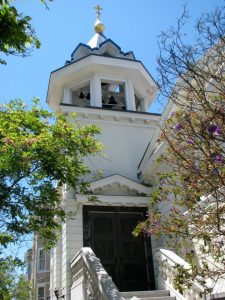The Seven Bells of Holy Trinity Cathedral
The seven bells of Holy Trinity Cathedral are one of our great civic and ecclesiastical treasures. Five of the seven were a gift from Tsar Alexander III of Russia in thanksgiving for the miraculous preservation of his life (and those of his family) from an assassination attempt. Two other bells were locally recast by Garrett & Co. from older bells that melted during one of several fires that seriously damaged the temple in the course of the years.
The largest bell of the set is a huge instrument of 5,765 pounds, and carries the following inscriptions (in Russian): “This bell was cast for the San Francisco Cathedral of the Orthodox American Mission during the Episcopate of Bishop Vladimir at the request of the hieromonk Joel, A.D. 1888. Weight 144 poods, 5 pounds. Moscow – N.D. Findlansky’s Bell Foundry. [This company name appears in English also.] In memory of the miraculous rescue of the Russian Emperor Alexander III and his most august family, October 17.” The transcription on the crown of the bell (in Slavonic) repeats the opening words of the Great Canon of St. Andrew of Crete, sung during Lent in the Orthodox Church: “He is my Protector and Helper unto salvation, my God, and Him will I glorify; the God of my fathers, and Him will I exalt, for greatly has He been glorified.”
The Great Bell is also adorned with four icons: Christ the Savior, the Theotokos (Mother of God), St. John the Baptist, and St. Vladimir. Decorative lattice-work frames the icons and circles the bell in several places. The four smaller Russian bells are likewise adorned with decorative scrollwork, and two carry the name of Findlansky, the bell maker.
The use of silver in the alloy and unusual tuning of the overtones gives Russian bells a distinctive sweet sound. San Francisco is very fortunate to have such a set of Russian bells, since few have survived, even in the Soviet Union, where they were confiscated wholesale and melted down for the making of cannon during the Revolution and World War II.
Of particular interest is the story of the fortuitous preservation of the bells following the earthquake and fire of 1906. Shortly before the disaster, the bells were removed from the church (then located on Powell street near Columbus). By this good fortune, the bells were saved from the fire, which destroyed the Cathedral. When the new Cathedral was built in 1909, the bells were brought out of storage and installed in its tower. As part of a general restoration program for the “new” Cathedral in 1978-79, the old unreinforced wooden tower was replaced by a steel and concrete tower, designed to withstand any future disaster.
The bells are rung manually, using ropes that cause the clappers to strike the sides of the bells, which themselves remain stationary. This permits the very complex patterns of tone and rhythm peculiar to the Russian style of bell ringing. The patterns are regulated by the rubrics of Orthodox Church services. The bells are rung before and after Divine Liturgy on Sundays and feastdays, as well as at the Vigil on the preceding evening. In fact, the bells are rung in one manner or another before all services and even during them at particularly solemn moments.
Individual differences in the bells (and the bell ringers) tend to lead to particular regional or local styles of bell ringing. The trained ear can identify bells being rung in the style of Pskov or Rostov, for example. We at Holy Trinity would not be surprised to hear visitors from Russia tell us that they had heard the San Francisco style of bell ringing!
Hear the Bells!
A number of videos of our bells being played are available on YouTube, including this one: https://youtu.be/wl-vbko-6VU
An old sample from the nineties of the ringing of the bells (trezvon), before the bells were reoriented in a more traditional style, is available at this link.